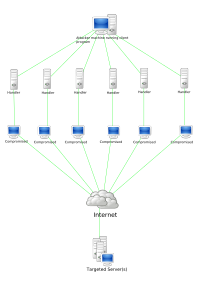
Photo from wikipedia
Emerging technologies such as software defined networks (SDN) and network function virtualization (NFV) enable flexibility in operation and a significant reduction of the costly hardware deployment in networks and improve… Click to show full abstract
Emerging technologies such as software defined networks (SDN) and network function virtualization (NFV) enable flexibility in operation and a significant reduction of the costly hardware deployment in networks and improve service agility too. Virtual network functions (VNF) are running as virtual machines on servers, and are organized in chains using service function chaining (SFC). Though many SFC algorithms were introduced, they mostly neglect the state of the underlying networking layers and infrastructure, considering static costs for the connections among the VNFs. In this paper, we apply a model that considers also the topology and current load information of the IP layer below. We formulate the problem using an integer linear program (ILP) and propose also a heuristic algorithm with the objective of avoiding link overloads in the networking layer. Thus, we solve the stated VNF-SFC problem similar to the basic traffic engineering (TE) problem in networks. We define different architectures to classify the solutions according to the amount of networking layer information applied in VNF-SFC solutions. We analyze the operation of the proposed solutions and show their benefits and drawbacks by numerical results of a case study.
Journal Title: Journal of Communications and Networks
Year Published: 2019
Link to full text (if available)
Share on Social Media: Sign Up to like & get
recommendations!